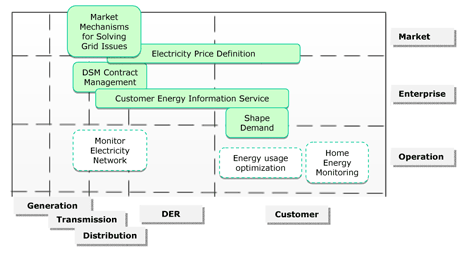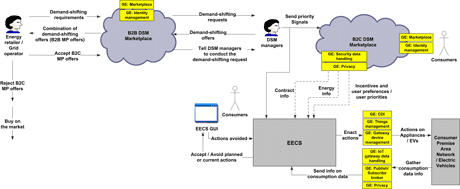by Luigi Briguglio, Massimiliano Nigrelli, Frank Eichinger, Javier Lucio Ruiz-Andino and Valter Bella
Market mechanisms facilitated by Future Internet technologies will help manage energy demand in the smart grid. New scenarios, stakeholders and services will need to be considered in the development of strategies to manage energy generation, distribution and consumption.
Power grids are facing new challenges as a consequence of an increase in the use of renewable energy sources (RES). The fluctuation in power supply from these energy sources results in insecure and unstable operating points. Furthermore, the integration of distributed energy resources (DER), as well as distributed information systems, poses serious stability and security challenges in power network operation and management, necessitating reinforcement of the distribution grid. In the scientific literature, a wide range of applications of control theory have been suggested for balancing renewable energy generation and consumption. Above all, to overcome these problems we need to start considering new scenarios, stakeholders and services.
In this article, we present a proposal for the adoption of market mechanisms in order to allow grid users and grid operators to implement, for instance, contractual peak shaving policies, thus avoiding issues associated with the stability of electricity distribution networks.
The proposed solution is based on the engagement of all stakeholders (such as energy retailers, grid operators, customers) in the “controlled eco-system” [1]. We make the assumption that more detailed information on energy consumption and the introduction of energy contracts with (dis)incentives will raise awareness of how the behaviour of groups of consumers could impact on energy production/distribution and consequently encourage more efficient energy use.
In this context, the role of marketplaces is fundamental for the management of energy prices, contracts and incentives based on the energy available/used in the grid (as shown in the Figure 1). The following scenario demonstrates how the eco-system could work.

Figure 1: Marketplaces for DSM: key functions
When energy retailers experience energy shortages, they buy energy at intra-day exchanges. When renewable production is low, this can be very expensive and a better option might be to ask their customers to consume less energy within a certain time frame. Similarly, grid operators monitor the electricity grid and may want to ask consumers to temporarily reduce their consumption in order to achieve grid stability. In a nutshell, such actions contribute to peak shaving in order to improve grid performance and reduce the need for auxiliary non-environmentally friendly peak production.
To this end, our team is defining and describing the architecture for a marketplace-based approach to demand-side management. In particular, the architecture is based on the idea of having two marketplaces (see Figure 2):
1. A B2C marketplace where consumers can subscribe to different demand-side-management programmes;
2. A B2B marketplace where “demand-side managers” can trade their bids for shifting energy demand.
The marketplaces are enabled by Future Internet technologies (identified by the yellow boxes in Figure 2) coming from the FI-WARE Generic Enablers (GE) infrastructure [2].

Figure 2: Electronic Marketplace for Energy: High-Level Architecture
The role of the demand-side manager might be taken on by the local distribution system operator, by energy retailers or by dedicated demand-side-manager companies.
The architecture assumes an infrastructure where consumers have installed at their premises an energy-efficiency control system (EECS) that monitors and controls energy consumption by changing their programming parameters, and allows DSM signals to be received from the demand-side manager based on the subscribed conditions and user preferences. This is only possible with an entity (normally software) that can ensure security and effective programming of the appliances to avoid any inconvenience.
In the architecture, customers have access to the B2C marketplace where they can see different offers for demand-side management programs from demand-side managers. These offers could be based on real-time tariff schemes and users can then choose to enter into a contract with one of these services with the aim of reducing the monthly bills. The offers might be coupled with energy contracts and the incentives may vary in terms of how much money is paid (or deducted from the bill) when a customer actually reacts to load-shifting requests. By using such a service, customers allow the grid operator to send demand-response signals to their energy-efficiency control system. The signals are used to initiate actions in the appliances connected to the energy-efficiency control system, in order to schedule operations (e.g. electric-vehicle charging, starting a machine or appliance, reducing or increasing the temperature of building by a given amount). It is important that contracts allow the customer to override DSM signals at any time in order to make manual decisions about how and when to use the contracted energy.
The results, partially presented in this article, will be further refined in the European project FINSENY (Future INternet for Smart ENergY) [3] and in particular in the work package 6 “Electronic Marketplace for Energy”. Modelling and specification activity is based on surveys (among different stakeholders) and a selection process which allowed identification of relevant use-case scenarios both from a business and a technical perspective. The specification of the architecture and its components will be completed by February 2013.
Acknowledgments:
This work was partially supported by the EU project “FINSENY - Future INternet for Smart ENergY” (FP7/2007-2013, Grant Agreement n. 285135). The authors gratefully acknowledge Pasquale Andriani, Giuseppa Caruso and Pierre Plaza Tron. Their activities in the first year of the FINSENY project allowed to provide the useful inputs for achieving the current results.
References:
[1] EU Commission Task Force for Smart Grids Expert Group 3: Roles and Responsibilities of Actors involved in the Smart Grids Deployment, http://ec.europa.eu/energy/gas_electricity/smartgrids/doc/expert_group3.pdf
[2] FI-WARE Security Generic Enablers:
https://forge.fi-ware.eu/plugins/mediawiki/wiki/fiware/index.php
[3] FINSENY - “Future Internet for Smart Energy”:
http://www.fi-ppp-finseny.eu/
Please contact:
Luigi Briguglio, Massimiliano Nigrelli
R&D Lab - Engineering Ingegneria Informatica S.p.A, Italy
E-mail: {luigi.briguglio, massimiliano.nigrelli}@eng.it
Frank Eichinger,
SAP Research Karlsruhe, Germany
E-mail:
Javier Lucio Ruiz-Andino,
Telefonica Investigación y Desarrollo, Spain
E-mail:
Valter Bella
Telecom Italia, Italy
E-mail:











